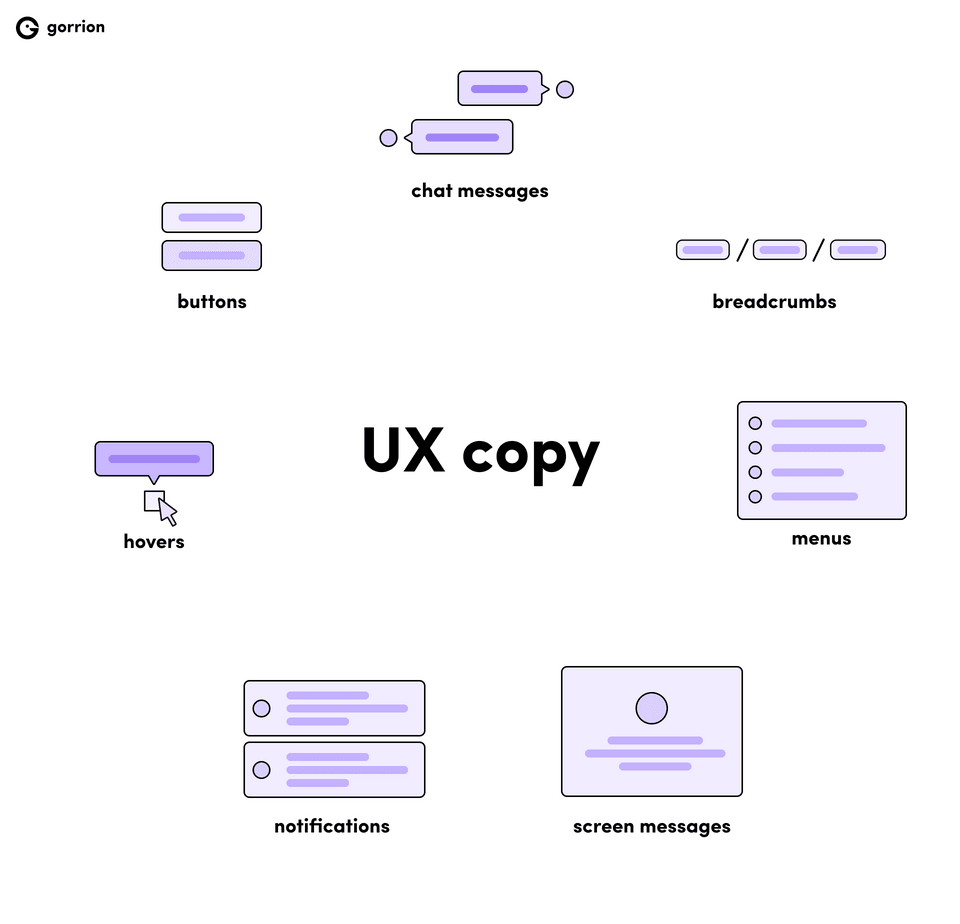You’ve got your UX designer, your technical writer, your marketing team, and your copywriters. Surely you don’t need any more roles in the mix? Wrong. You’re missing UX writers and your product is worse for it.
In all this talk about user-centric design and the best software development practices, we tend to forget about one crucial aspect of user experience – the words we speak. After all, it’s not just about how the software looks and feels, right? It’s also about what it communicates. Yet, we’re eager to overlook the buttons, the confirmation messages, the navigation bar. As long as these work, they’re insignificant. But who exactly makes them work? The heroes of this article – UX writers.
Who’s a UX writer?
UX copywriters (also called simply UX writers, and sometimes UI writers) are people within the product design team who are responsible for writing digital product copy (such as user prompts) and content for user-related touchpoints (such as chatbots).
Their role is to use words to guide product users (or website visitors) to where they need to go. Have you ever found yourself wandering around an app and not knowing how to change the settings you didn’t like or find the view you needed? While these problems are often attributed to UX designers, it’s just as likely that they occured because the creators didn’t have UX writers on their team.
Who do UX writers work with?
To achieve their goal, UX writers collaborate with product development teams, especially with UI and UX designers. They learn the product inside and out, because in order to explain it to someone else (often using 10 characters or less), they need to understand it perfectly themselves. This is why they are close to software developers and product managers.


Have a project in mind?
Let’s meet - book a free consultation and we’ll get back to you within 24 hrs.
UX writing is also an important part of the overall design of a product. That’s why UX writers engage in the overall UX design process, creating user flows, doing user testing. In fact, these responsibilities are so entwined that usually UX writers are a part of the design team in company structures.
What does a UX writer create?
Inside your product (and outside of it, as well!), you’ll find dozens of touchpoints that require UX writing. Some of them are:
- buttons
- screen messages
- notifications
- hovers
- menus
- breadcrumbs
- chat messages
What’s good UX writing?
You may think these things are insignificant. Who cares about a login button, right? I could design that copy myself! But then… do you really know the difference between “Log in,” “Sign in,” and “Sign up”? UX writers do.
There’s an old adage that a good translation is one that you don’t pay attention to, and I imagine it’s the same with proper UX writing. Only when we fumble around the navigation bar looking for the right tab, do we notice the bad copy. Only when we’re stuck with an intelligible error message, do we grow frustrated.
There are a few characteristics that make UX writing good:
- clear – it’s unambiguous and to the point, it never leaves you thinking whether it was your email or password that was incorrect;
- concise – most of UX writing is confined by a character limit, so a good UX writer knows how to squeeze the most meaning in the least amount of space;
- functional – because of the character limits, all UX writing has to have a purpose, there’s no space for “fluff;”
- informative – the messaging has to convey meaning and information that the users are after at that point of their journey and guide users to their destination;
- actionable – the user must know from the copy what to do next; good UX writing never makes them question their steps.
How does UX writing benefit your product?
I think we can all instinctively agree that bad user experience makes for a bad product and low customer satisfaction. And there’s plenty of evidence to that. “88% of online consumers are less likely to return to a site after a bad experience,” says Justin Mifsud, founder of Usability Geek. “44% of online shoppers will tell their friends about a bad experience,” according to KissMetrics. Almost 35% visitors will leave a website due to poor content structure, per GoodFirms. I could go on forever.
Bad UX writing translates directly into bad user experience. It confuses people. It misdirects them. It frustrates. And it makes them leave. But should you view UX writing as a reluctant necessity? No! It’s actually a cornucopia of benefits for you!
Improved brand perception
This one’s obvious. I’ve already quoted some statistics about the impact of UX design on customers. And just like bad UX experiences affect brand perception negatively, positive UX experiences improve brand perception significantly.
Easier onboarding
Intuitive UX copy is critical for successful customer onboarding. It’s when your customers are most confused about navigating the product and possibly overwhelmed by it. It’s also when they are making decisions whether to commit and invest in it. UX writing can make the onboarding experience so much smoother and more enjoyable.
Increased retention
It’s simple. Users that had a positive onboarding experience (for example during a free trial) are more likely to become happy customers. Happy customers – ones that didn’t have frustrating experiences or whose issues were resolved quickly – are more likely to remain with your company for longer. According to Forrester, this can up your conversion rates by whopping 400%!
Lower costs
How much do you spend on user support now? And how many of your issues could have been resolved, had the UX design been more intuitive or the error messages clearer? Clear and understandable UX writing can be your “first line of support,” effectively decreasing the costs of actual customer support.
How UX writers differ from content and technical writers?
There seems to be a lot of confusion between what a UX writer is, as opposed to a marketing copywriter, or a technical writer. No wonder, they all work on your product, and they all wield words as their weapon! On top of that, UX writing is a relatively new discipline, so even major tech companies often define the job description of their UX writers as they go.
Companies are only now starting to see the need to have (and the benefits of) a dedicated, experienced UX writer who knows how to design in-product copy well. Until now, it was not uncommon for companies to make it the job of technical writers, at best. At worst, they would expect software developers or UX designers to just come up with the content as they were developing the product.
So let’s clear up the confusion and figure out if you really need three different writers on your team.
Marketing copywriters / content specialists
Now, their role should be pretty clear. Marketing people rarely venture inside the product design process, and content specialists are rarely called upon to come up with a clever idea for an in-product button.
Marketing copy is mostly directed at potential buyers and intended to sell products. Even when it is directed at customers, there is oftentimes a world of difference between the product user and the product buyer (especially in B2B marketing). In any case, marketing copy is mostly persuasive, emotive, and written to convince its intended recipient to engage with the brand and, of course, drive sales.
Examples of what content specialists might create for you include blog articles, ebooks and white papers, social media posts, video and webinar scripts, newsletters and email campaigns, product and landing pages, and more. But it’s important to remember that they are responsible not just for the copy, but for the overall content strategy and brand voice as well.
About landing pages, though. There’s an interesting intersection between the work of a UX writer and a marketing one. User experience is a huge part of what makes your website great and your website is one of your most powerful marketing assets. Which is why, if your marketing team isn’t well-versed in UX best practices, it might be smart to engage a UX writer to at least consult on the project. They can advise on things like the information architecture, menu labels, breadcrumbs, CTA buttons, etc.
Technical writers
Similar to UX writers, technical writers are a part of the product team. There are also other reasons why these two roles are often equated.
As I’ve already mentioned, technical writers would commonly be called upon to come up with UX copy since they have writing skills and very good knowledge of the product. What’s more, they also usually write content that’s instructional and aims to guide or solve user problems. Technical writing will therefore include assets such as onboarding instructions, how-to manuals, scripts for tutorial videos, or FAQs.
So there can be a significant overlap between them and a UX writer. For example, these two roles can combine their knowledge and experience and work together on preparing chat bot responses based on most frequently asked questions.
But technical writers also frequently create internal documentation. They work much closer with programmers on documenting the software development process. This is needed to have clarity across all development teams, but also for the customers, if your product offers APIs, integrations, or customizations. This knowledge goes much deeper than what’s expected of a UX writer.
Conclusion
To answer our initial question: do you need a UX writer? If you’re developing a digital product, then hell yea! UX writing can elevate it by eliminating customer pain points, guiding user behavior, and improving customer experience.
However, there’s a caveat to whether you need a UX writing role. Unless your software platform is large, or you have multiple platforms, or your product is constantly evolving, or you’re only in the process of developing it, you probably don’t need a separate “UX writer” position on your team. You just need someone with the skill.
So, if you have a well-established product with only minor changes, it’s possible to have a technical writer and a UX designer that work together on the copy. That is, as long as they have relevant training and competencies to do that.
It’s important to distinguish between the roles your team needs to fill, and the headcount you need to make it happen. Writing roles require similar sets of skills, so with the right upskilling and enough slack time, your technical writer can also be your UX writer. What’s important here is that you don’t ignore the need for a UX writing role. After all, it’s the be all and end all of user experience.


Have a project in mind?
Let’s meet - book a free consultation and we’ll get back to you within 24 hrs.
At Gorrion, Dominika Stankiewicz manages content. Having spent a decade in marketing and communications, she’s the master of the written word and the guardian of style. On our blog she shares her experience in B2B product marketing to help SaaS companies plan and execute their go-to-market strategy. In her spare time, she reviews manuscripts for publishers and bakes cakes. She loves cats, books, and American football.
Other worthy reads







